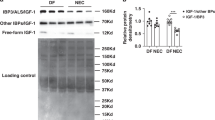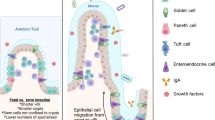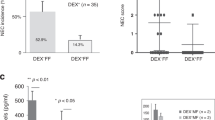Abstract
Background:
The aim of this study was to investigate the effects of human β-defensin-3 (hBD3) on intestinal wound healing and in a neonatal rat model of necrotizing enterocolitis (NEC).
Methods:
Enterocyte migration and proliferation were detected in vitro and in vivo. The role of chemokine receptor CCR6 and its downstream signaling pathway was assessed. Newborn Sprague–Dawley rats were randomly divided into four groups: Control+NS, Control+hBD3, NEC+NS, and NEC+hBD3. Body weight, histological score, survival time, cytokines expression, and mucosal integrity were evaluated.
Results:
hBD3 could stimulate enterocyte migration, but not proliferation, both in cultured enterocytes and in the NEC model. Neutralizing antibody and small interfering RNA confirmed this stimulatory effect was mediated by CCR6. Furthermore, hBD3 induced Rho activation, myosin light chain 2 phosphorylation, and F-actin accumulation. The bactericidal activity of hBD3 was maintained throughout a broad pH range. Strikingly, hBD3 administration decreased the incidence of NEC, increased the survival rate, and reduced the severity of NEC. Moreover, hBD3 reduced the proinflammatory cytokines expression in ileum and serum and preserved the intestinal barrier integrity.
Conclusion:
This study provided evidence that the antimicrobial peptide hBD3 might participate in intestinal wound healing by promoting enterocyte migration and show beneficial effects on newborn rats with NEC.
Similar content being viewed by others
Log in or create a free account to read this content
Gain free access to this article, as well as selected content from this journal and more on nature.com
or
References
Neu J, Walker WA . Necrotizing enterocolitis. N Engl J Med 2011;364:255–64.
Sodhi CP, Shi XH, Richardson WM, et al. Toll-like receptor-4 inhibits enterocyte proliferation via impaired beta-catenin signaling in necrotizing enterocolitis. Gastroenterology 2010;138:185–96.
Hackam DJ, Good M, Sodhi CP . Mechanisms of gut barrier failure in the pathogenesis of necrotizing enterocolitis: Toll-like receptors throw the switch. Semin Pediatr Surg 2013;22:76–82.
Semple F, Dorin JR . ß-Defensins: multifunctional modulators of infection, inflammation and more? J Innate Immun 2012;4:337–48.
Meisch JP, Vogel RM, Schlatzer DM, Li X, Chance MR, Levine AD . Human ß-defensin 3 induces STAT1 phosphorylation, tyrosine phosphatase activity, and cytokine synthesis in T cells. J Leukoc Biol 2013;94:459–71.
Jenke AC, Zilbauer M, Postberg J, Wirth S . Human ß-defensin 2 expression in ELBW infants with severe necrotizing enterocolitis. Pediatr Res 2012;72:513–20.
Armogida SA, Yannaras NM, Melton AL, Srivastava MD . Identification and quantification of innate immune system mediators in human breast milk. Allergy Asthma Proc 2004;25:297–304.
Seo EJ, Weibel S, Wehkamp J, Oelschlaeger TA . Construction of recombinant E. coli Nissle 1917 (EcN) strains for the expression and secretion of defensins. Int J Med Microbiol 2012;302:276–87.
Underwood MA, Kananurak A, Coursodon CF, et al. Bifidobacterium bifidum in a rat model of necrotizing enterocolitis: antimicrobial peptide and protein responses. Pediatr Res 2012;71:546–51.
Dwinell MB, Eckmann L, Leopard JD, Varki NM, Kagnoff MF . Chemokine receptor expression by human intestinal epithelial cells. Gastroenterology 1999;117:359–67.
Izadpanah A, Dwinell MB, Eckmann L, Varki NM, Kagnoff MF . Regulated MIP-3alpha/CCL20 production by human intestinal epithelium: mechanism for modulating mucosal immunity. Am J Physiol Gastrointest Liver Physiol 2001;280:G710–9.
Schutyser E, Struyf S, Van Damme J . The CC chemokine CCL20 and its receptor CCR6. Cytokine Growth Factor Rev 2003;14:409–26.
Hirsch T, Spielmann M, Zuhaili B, et al. Human beta-defensin-3 promotes wound healing in infected diabetic wounds. J Gene Med 2009;11:220–8.
Mammen JM, Matthews JB . Mucosal repair in the gastrointestinal tract. Crit Care Med 2003;31(8 Suppl):S532–7.
Wu Z, Hoover DM, Yang D, et al. Engineering disulfide bridges to dissect antimicrobial and chemotactic activities of human beta-defensin 3. Proc Natl Acad Sci USA 2003;100:8880–5.
Vongsa RA, Zimmerman NP, Dwinell MB . CCR6 regulation of the actin cytoskeleton orchestrates human beta defensin-2- and CCL20-mediated restitution of colonic epithelial cells. J Biol Chem 2009;284:10034–45.
Chaturvedi LS, Marsh HM, Basson MD . Role of RhoA and its effectors ROCK and mDia1 in the modulation of deformation-induced FAK, ERK, p38, and MLC motogenic signals in human Caco-2 intestinal epithelial cells. Am J Physiol, Cell Physiol 2011;301:C1224–38.
Totsukawa G, Yamakita Y, Yamashiro S, Hartshorne DJ, Sasaki Y, Matsumura F . Distinct roles of ROCK (Rho-kinase) and MLCK in spatial regulation of MLC phosphorylation for assembly of stress fibers and focal adhesions in 3T3 fibroblasts. J Cell Biol 2000;150:797–806.
De Plaen IG . Inflammatory signaling in necrotizing enterocolitis. Clin Perinatol 2013;40:109–24.
Luk GD, Bayless TM, Baylin SB . Diamine oxidase (histaminase). A circulating marker for rat intestinal mucosal maturation and integrity. J Clin Invest 1980;66:66–70.
Pérez-Cañadillas JM, Zaballos A, Gutiérrez J, et al. NMR solution structure of murine CCL20/MIP-3alpha, a chemokine that specifically chemoattracts immature dendritic cells and lymphocytes through its highly specific interaction with the beta-chemokine receptor CCR6. J Biol Chem 2001;276:28372–9.
Schibli DJ, Hunter HN, Aseyev V, et al. The solution structures of the human beta-defensins lead to a better understanding of the potent bactericidal activity of HBD3 against Staphylococcus aureus. J Biol Chem 2002;277:8279–89.
Niyonsaba F, Ushio H, Nakano N, et al. Antimicrobial peptides human beta-defensins stimulate epidermal keratinocyte migration, proliferation and production of proinflammatory cytokines and chemokines. J Invest Dermatol 2007;127:594–604.
Funderburg NT, Jadlowsky JK, Lederman MM, Feng Z, Weinberg A, Sieg SF . The Toll-like receptor ½ agonists Pam(3) CSK(4) and human ß-defensin-3 differentially induce interleukin-10 and nuclear factor-?B signalling patterns in human monocytes. Immunology 2011;134:151–60.
Wilson CL, Ouellette AJ, Satchell DP, et al. Regulation of intestinal alpha-defensin activation by the metalloproteinase matrilysin in innate host defense. Science 1999;286:113–7.
Semple F, Webb S, Li HN, et al. Human beta-defensin 3 has immunosuppressive activity in vitro and in vivo. Eur J Immunol 2010;40:1073–8.
Semple F, MacPherson H, Webb S, et al. Human ß-defensin 3 affects the activity of pro-inflammatory pathways associated with MyD88 and TRIF. Eur J Immunol 2011;41:3291–300.
Zilbauer M, Jenke A, Wenzel G, et al. Expression of human beta-defensins in children with chronic inflammatory bowel disease. PLoS ONE 2010;5:e15389.
Meisch JP, Nishimura M, Vogel RM, et al. Human ß-defensin 3 peptide is increased and redistributed in Crohn’s ileitis. Inflamm Bowel Dis 2013;19:942–53.
Salzman NH, Hung K, Haribhai D, et al. Enteric defensins are essential regulators of intestinal microbial ecology. Nat Immunol 2010;11:76–83.
Feng J, Besner GE . Heparin-binding epidermal growth factor-like growth factor promotes enterocyte migration and proliferation in neonatal rats with necrotizing enterocolitis. J Pediatr Surg 2007;42:214–20.
Rahim S, Üren A . A real-time electrical impedance based technique to measure invasion of endothelial cell monolayer by cancer cells. J Vis Exp 2011;50:e2792.
van Gils JM, Derby MC, Fernandes LR, et al. The neuroimmune guidance cue netrin-1 promotes atherosclerosis by inhibiting the emigration of macrophages from plaques. Nat Immunol 2012;13:136–43.
Houle VM, Park YK, Laswell SC, Freund GG, Dudley MA, Donovan SM . Investigation of three doses of oral insulin-like growth factor-I on jejunal lactase phlorizin hydrolase activity and gene expression and enterocyte proliferation and migration in piglets. Pediatr Res 2000;48:497–503.
Neal MD, Sodhi CP, Dyer M, et al. A critical role for TLR4 induction of autophagy in the regulation of enterocyte migration and the pathogenesis of necrotizing enterocolitis. J Immunol 2013;190:3541–51.
Caplan MS, Hedlund E, Adler L, Hsueh W . Role of asphyxia and feeding in a neonatal rat model of necrotizing enterocolitis. Pediatr Pathol 1994;14:1017–28.
Sheng Q, Lv Z, Cai W, Song H, Qian L, Wang X . Protective effects of hydrogen-rich saline on necrotizing enterocolitis in neonatal rats. J Pediatr Surg 2013;48:1697–706.
Author information
Authors and Affiliations
Corresponding author
Rights and permissions
About this article
Cite this article
Sheng, Q., Lv, Z., Cai, W. et al. Human β-defensin-3 promotes intestinal epithelial cell migration and reduces the development of necrotizing enterocolitis in a neonatal rat model. Pediatr Res 76, 269–279 (2014). https://doi.org/10.1038/pr.2014.93
Received:
Accepted:
Published:
Issue date:
DOI: https://doi.org/10.1038/pr.2014.93
This article is cited by
-
Values of serum intestinal fatty acid-binding protein, fecal calprotectin, and fecal human β-defensin 2 for predicting necrotizing enterocolitis
BMC Pediatrics (2024)
-
Role of Rho GTPases in inflammatory bowel disease
Cell Death Discovery (2023)
-
Bioinformatics analysis of potential key genes and pathways in neonatal necrotizing enterocolitis
BMC Pediatrics (2022)
-
Human β-defensin-3 reduces excessive autophagy in intestinal epithelial cells and in experimental necrotizing enterocolitis
Scientific Reports (2019)
-
Investigation into the antimicrobial action and mechanism of a novel endogenous peptide β-casein 197 from human milk
AMB Express (2017)



